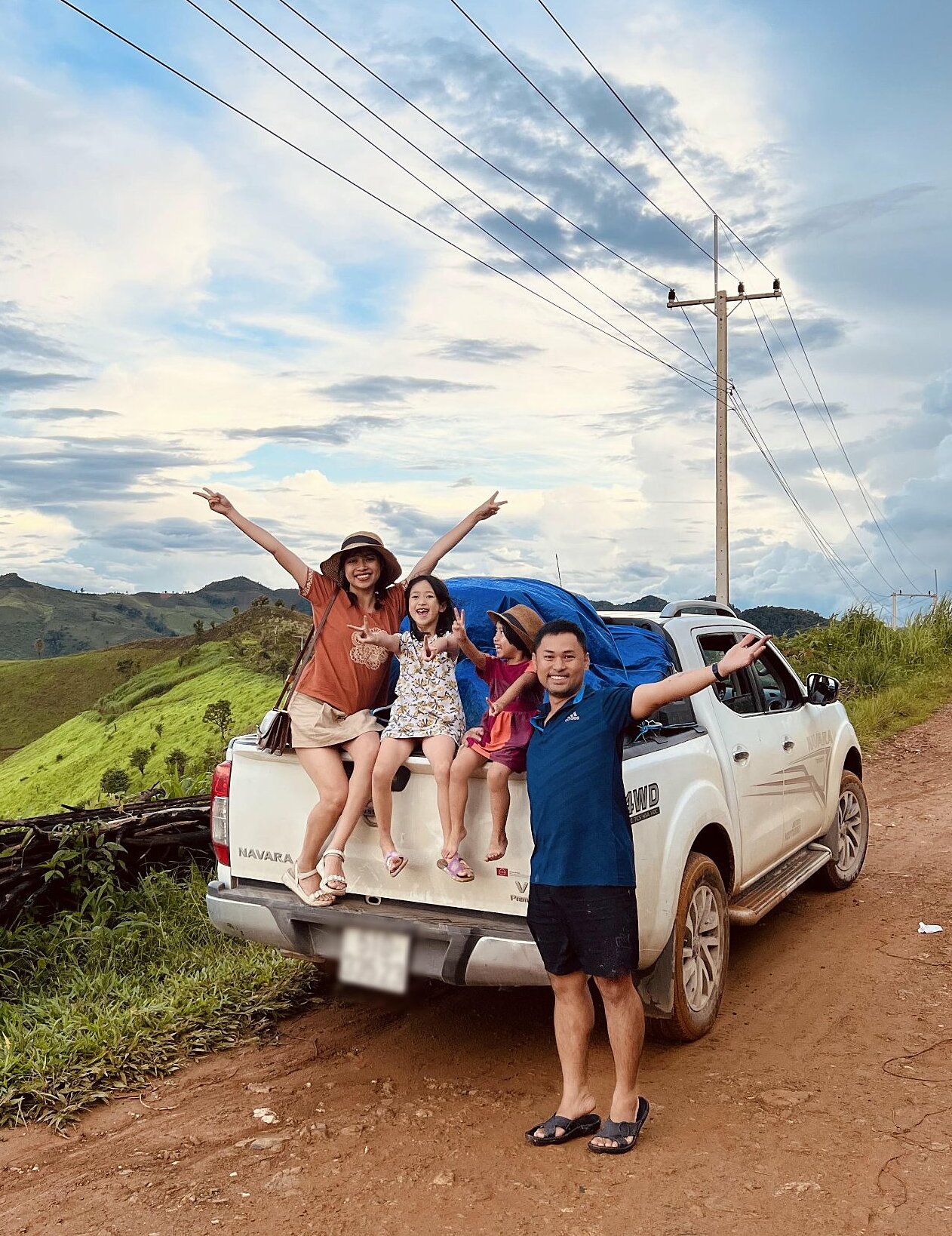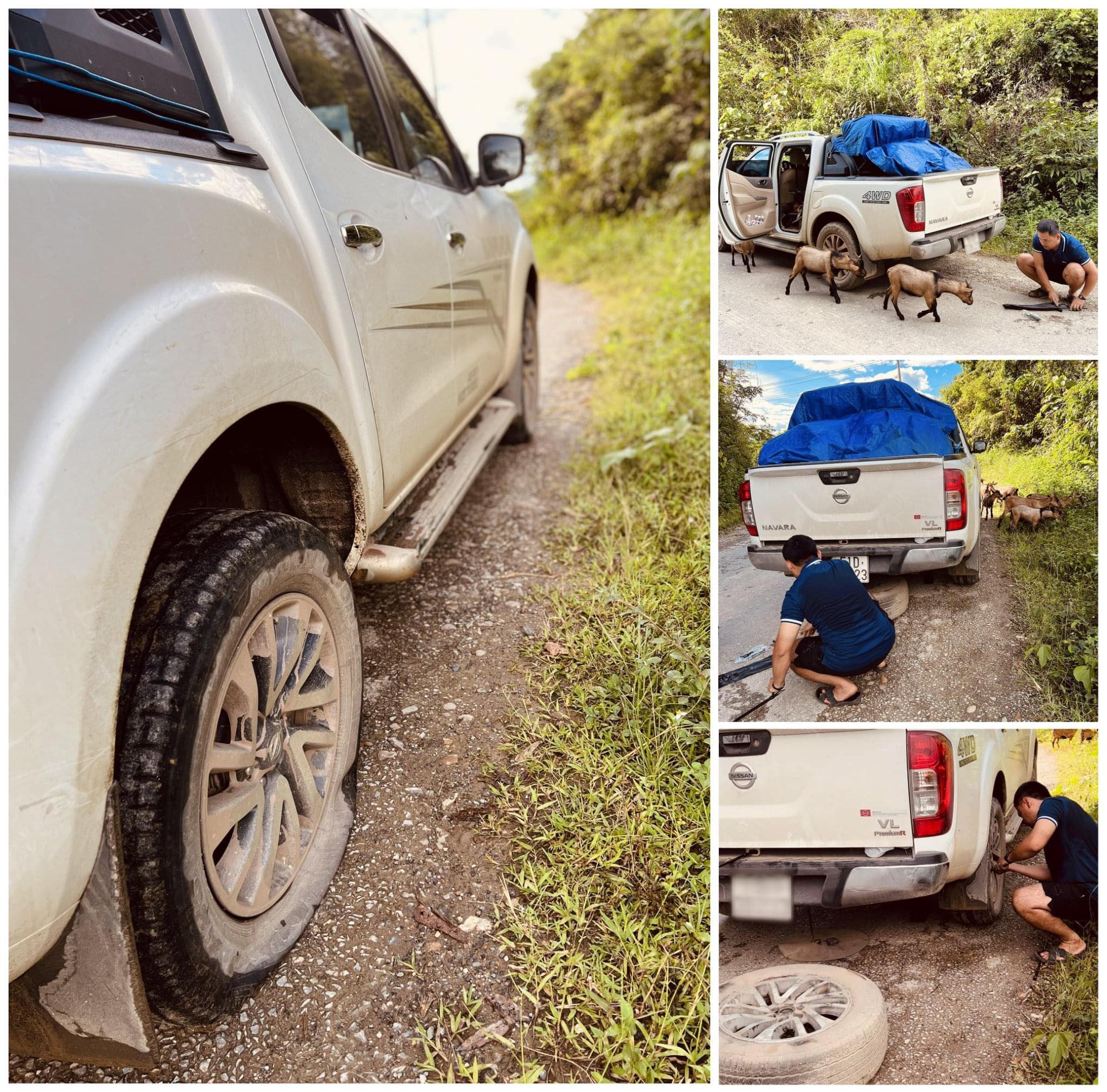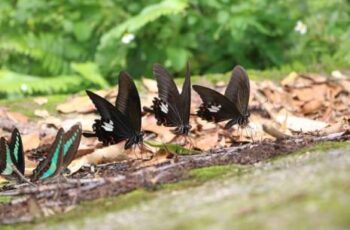Ad Blocker Detected
Our website is made possible by displaying online advertisements to our visitors. Please consider supporting us by disabling your ad blocker.
Ms. Ha’s family had a memorable summer when they traveled together through Vietnam – Laos – Cambodia in 45 days, with more than 10,000 km.
The family of Ms. Thu Ha and Mr. Khuat Hieu (Ho Chi Minh City) just made a self-driving journey across three countries Vietnam – Laos – Cambodia in 45 days, from June 6. The couple has two children, 8 and 3 years old respectively.
The trip was made from Mr. Hieu’s idea. Claiming to be someone who likes to drive cars, Mr. Hieu has loved speed games since he was young, so being behind the wheel for several hours a day is a joy for him, not a pressure. In addition, self-driving helps families go to quiet places with many beautiful natural landscapes, rather than the crowded places that tours often visit.
Initially, the family planned to go through Vietnam to the North to visit Ms. Ha’s parents and explore the Northwest region, but when drawing the route on the map, they did not want to repeat the return route, so they decided to take a detour. through Laos and Cambodia to make the journey more interesting.

Ms. Ha’s family’s journey.
When planning, Ms. Ha estimated that she would have to travel about 7,000 km so she was quite bored, but because it was her husband’s long-cherished dream, she agreed to go. “Once you want it, you will find a way to make it happen, so I decided to become your companion on this journey. We arranged our work, as soon as the children started summer vacation, we left, without delay because it had been 2 years since the whole family could go out together due to the Covid-19 epidemic,” Ms. Ha shared.
Both husband and wife are freelance workers so they can proactively give up some work to make time for the trip. The work they are doing will be arranged remotely. “We have to trade off some important things because we can’t solve them directly, but not everything will go smoothly,” Ms. Ha said.
The itinerary is both planned and improvised depending on the mood and health of the whole family. The family divided the trip into 5 stages:
Stage 1 (9 days): Ho Chi Minh City – Dak Lak – Kon Tum – Hoi An – Da Nang – Hue – Quang Binh – Hanoi
Leg 2 (11 days): Ha Long – Bac Ninh – Tuyen Quang – Ha Giang – Cao Bang – Bac Kan – Thai Nguyen – Hanoi
Stage 3 (7 days): Hanoi – Lao Cai – Lai Chau – Dien Bien – Son La – Hoa Binh – Hanoi
Stage 4 (4 days): Bac Ninh – Lang Son – Hanoi – Ninh Binh
Stage 5 (14 days): Hanoi – Laos (Luang Phrabang/ Vientiane/ Kaysone/ Kakse) – Thailand (Mukdahan) – Cambodia (Siem Riep/Phnom Penh) – Chau Doc – Rach Gia – Ca Mau – Ho Chi Minh City
First, traveling along the length of the country from South to North, the family felt the changes in landscape, climate, architecture, people and saw “how rich and diverse Vietnamese nature and culture are.” ”. From Ho Chi Minh City, they went to the Central Highlands with fertile red soil and golden sunshine like honey. Early in the morning, while still covered with blankets on the top of Mang Den, by noon the whole family had arrived at the scorching Central Coast, up to the North Central region with majestic limestone mountains like movie scenes. Going to the North, they visited the thousand-year-old culture of the Northern Delta, experienced a cruise in Ha Long Bay and explored the Northwest mountains.
“If in the early days, just seeing a low, undulating mountain rising in the middle of the plain made the whole family admire, then when we reached the Northwest, we were truly satisfied with the soaring mountain ranges and steep cliffs. stand”. They also have the opportunity to compare the differences between architecture between regions, how the houses of the Northwest people are different from the houses of the Central Highlands people, or visit ancient citadels to know what places the kings and lords lived in the past.

The whole family stopped on the way in Laos. Photo: NVCC
Ms. Ha said, the scenery was no different when her family moved to Laos and Cambodia. However, in these two countries, the roads are deserted and there are fewer vehicles than in Vietnam. To come here, in addition to preparing personal documents such as a passport, it is also required to have a Vietnam – Laos – Cambodia intermodal driving license and the driver needs an international driver’s license.
Arriving in Laos, the whole family was surprised because the weather was very cool. “Coming from the hot sun of Central Vietnam to Laos, it feels like being in Da Lat,” Ha said. Many people at home told the couple that Laos is sad because there are few people and only mountains and forests, but that is the couple’s “taste”. As a person who likes to drive, Mr. Hieu also likes the “no speed limit” roads in Laos, and this country has many pickup trucks due to the mainly mountainous terrain.
Cambodia, where the couple went more than 10 years ago, when they returned, they were impressed with the rapid pace of development and admired this country’s way of doing tourism and preserving heritage when they came to Siem Riep and explored the country. destroyed the Angkor civilization.
During 45 days of traveling all the way, the family traveled 10,987 km, which they estimated was equivalent to 1/4 of the earth’s circumference, a total of 200 hours of driving. With that amount of time, they have gone through many experiences together, some happy, some sad.
The family broke down when they reached the top of Ma Pi Leng, were amazed by the beauty of Ban Gioc waterfall and Lenin stream (Cao Bang), proud to set foot on Fansipan peak – the roof of Indochina, the northernmost check-in. and the southernmost point of the country, but we cannot avoid the feeling of sadness when witnessing that 21,000 hectares of U Minh Thuong forest are now only swamps and weeds.

Punctured tire in the middle of the forest. When traveling for a long time, especially in deserted places, tourists must be equipped with basic car repair skills in case of unexpected situations.
However, the most memorable memory was when traveling from Xam Neua to Luang Phrabang, Laos. According to estimates, they will depart at 7:00 a.m. and arrive at Luang Phrabang at 7:00 p.m. However, halfway through the trip, the car’s tire blew out. Even though they had a spare tire and Mr. Hieu knew some basic skills to fix problems, the rocky, muddy roads and steep mountain slopes made them unable to forget the feeling of “holding their breath” when they were still traveling at 11 p.m. On the “dinosaur’s spine”, there are only clouds and mountains on all four sides, and you can only run at a maximum speed of 15 km/h, while you still have 100 km to reach the city. Even though that day was a bright full moon night, the clouds drifted lazily, and at one point the car sank into the clouds, the couple “was no longer in the mood to admire the scenery.” They still cannot forget the feeling of happiness when they saw the asphalt road appear at the foot of the mountain.
Another memory is that the family moved to the Northwest provinces during the rainy season. When coming from Lai Chau to Dien Bien, the whole family was worried because they encountered a landslide and the car could not pass. It was 7:00 p.m. With no other choice, Ms. Ha’s family had to stop the car and wait for the rescue team to come and fix it. The whole family waited for nearly 4 hours in the pouring rain and it was dark outside. Fortunately, the rescue team arrived in time so her family was still able to reach Dien Bien at night, but it was also “an unforgettable experience on the journey”.
There are also times when the journey seems to have to end early, like when there is a problem with the car’s documents. They applied for an intermodal permit to take the car through Laos – Cambodia in Ho Chi Minh City early, and was granted 60 days, but accidentally stayed in the North for too long, so when they arrived in Laos, the permit had almost expired. They consulted sources that said it could be extended in their home country, so they continued on their planned route, intending to extend it in Vientiane, but when they arrived here, no agency accepted their case, forcing them to do so. must return to Vietnam before the license expires.
At that time, it seemed that when we returned to Vietnam, we would return forever, but the whole family encouraged each other and accepted everything that happened with the most positive spirit to complete the initial plan. Fortunately, the procedure in Ha Tinh was convenient and quick and the family returned to Laos to continue their journey. “It’s also interesting, the family can experience one more day in 3 countries: breakfast in Ha Tinh, lunch in Laos (Kaysone), dinner in Thailand (Mukdahan)”, Ms. Ha shared.
One thing that many people wonder about is whether there are any difficulties for children traveling with them, in addition, whether the children are too young to feel it all, or get tired if they travel long distances… and Ms. Ha admits that there are many difficulties. “The children often have unpredictable weather and do not always cooperate, but my husband and I accept it and consider it a part of traveling.” Through the trip, Ha hopes to instill in her children some love of nature and exploring new lands. The itinerary will depend on the children’s mood and health. “However, I always try to explain to my children: We can go fast or slow, but we never give up halfway.”
This is the first time the family has driven across the border by car. They felt happy because they had achieved their goal of safely completing the route around the three Indochina countries. At the end of the trip, the family realized that “if you want it enough, you can do it.” In the future, their dream is to make a self-driving trip around the United States.


